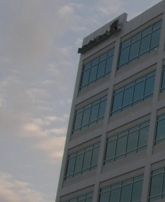Butterfield loses over $200M
 (CNS): Butterfield Bank lost over $207.6 million in 2010, according to its year end results, which was only slightly less than the loss of $213.4 million the year before. In a release announcing the results, the bank said that on a normalised basis, net income was $14.8 million for 2010 compared to $21 million in 2009. The bank’s 2010 loss was driven primarily by non-recurring losses associated with the strategy to de-risk the balance sheet, bank officials said, including realised losses of $113.8 million on the sale of asset-backed securities in the first quarter, the recording of other-than-temporary impairments of $60.5 million in the first quarter on structured investment vehicles, net provisions of $31.8 million taken primarily in respect of large hospitality-related corporate loans and restructuring costs of $12.4m.
(CNS): Butterfield Bank lost over $207.6 million in 2010, according to its year end results, which was only slightly less than the loss of $213.4 million the year before. In a release announcing the results, the bank said that on a normalised basis, net income was $14.8 million for 2010 compared to $21 million in 2009. The bank’s 2010 loss was driven primarily by non-recurring losses associated with the strategy to de-risk the balance sheet, bank officials said, including realised losses of $113.8 million on the sale of asset-backed securities in the first quarter, the recording of other-than-temporary impairments of $60.5 million in the first quarter on structured investment vehicles, net provisions of $31.8 million taken primarily in respect of large hospitality-related corporate loans and restructuring costs of $12.4m.
On a normalised basis, revenues from operations, before provisions for credit losses, were down from $332.1 million at year-end 2009 to $321.3 million at year-end 2010. Net interest income before provisions for credit losses was down 4% year on year to $178.9 million, owing to compressed margins in the low interest rate environment and limited loan demand. Non-interest income declined by 1.9%, from $145.2 million in 2009 to $142.4 million, in line with global recessionary declines, the bank stated. Expenses before one-time items declined from $300.5 million in 2009 to $294.8 million in 2010, despite expenditures on technology, asset-liability management and liquidity support.
Olivier Sarkozy, who led the investment in the bank on behalf of The Carlyle Group, said that, while “unfortunate”, the losses realised represented the culmination of the balance sheet restructuring that was necessary to put the bank back on a path of prudent risk management and sustainable growth. “We are pleased with the progress the Bank has made in this regard and happy that the Bank’s results are consistent with, if not slightly better than, our original projections,” he added.
At 31 December 2010, Butterfield had a tangible common equity ratio of 5.8% from 0.9% a year ago, total capital ratio of 21.6% and tier 1 capital ratio of 15.7%. The bank’s net book value per share was $1.09 at 31 December 2010.
Brad Kopp, Butterfield’s President and Chief Executive Officer, said 2010 was a year of “building a strong foundation amongst challenging economics,” starting with the capital raise bringing in new investors and an over-subscribed rights offering the banks good liquidity position allowed it to finalise the process of ridding the balance sheet of problematic assets. “This leaves us with a strong capital base to withstand continued uncertainty in the global economic outlook and to support growth as our economies recover,” he added.
With respect to the bank’s overall asset quality, Kopp said it was important for the bank to reduce exposure on its balance sheet promptly and to re-invest in high quality securities, whilst ensuring appropriate liquidity. “Non-accrual loans at 31 December 2010 amounted to approximately $160 million, down from over $230 million a year ago, and equivalent to 3.9% of our total loan portfolio. Subsequent to year end, we settled a troubled hospitality loan, further reducing our non-accrual loans to 3.75% of total loans, compared to 5.37% a year earlier. We continue to work with our borrowers to find mutually agreeable repayment solutions,” he added.
To date, the Bank said it had taken action to place two hotel properties in Bermuda in receivership, which was deemed the best course of action to protect the value of the assets and safeguard the interests of Butterfield shareholders. The properties continue to operate under management overseen by the receivers, with a view to selling them as going concerns.
During the year, Butterfield undertook restructurings in several of its businesses and jurisdictions, making changes in support of its strategy to focus resources on the core businesses of community banking and wealth management in jurisdictions where the bank has a meaningful market presence.
The bank also said it had made substantial progress on the implementation of its upgraded technology platform and is now well placed to introduce new banking systems in the Cayman Islands and Bermuda in 2011.
“Although the economic circumstances in the markets in which the Bank operates remain somewhat uncertain,” Kopp said, “our strategic focus on community banking and wealth management services, along with the strong capital foundation we have in place, will, I believe, allow us toachieve future growth and sustained profitability.”
Senior Executive VP, Caribbean, Conor O’Dea, said the bank was encouraged by new management appointments including a new Head of Group Asset Management who will be tasked with growing that element of the banks business.
“A stronger asset management function will complement our fiduciary and private banking services,” O’Dea said. “Our franchise in the Cayman Islands remains focused on growth, innovation and enriching our community. We continue to contribute to the success of the financial services industry and offer exceptional customer services in the Cayman Islands,” he added.
Category: Business


Should we be concerned about the stability of Butterfield Bank?
The news is nothing new to be honest, it was to be expected. That figure is just a combined amount of what they reported all year long.